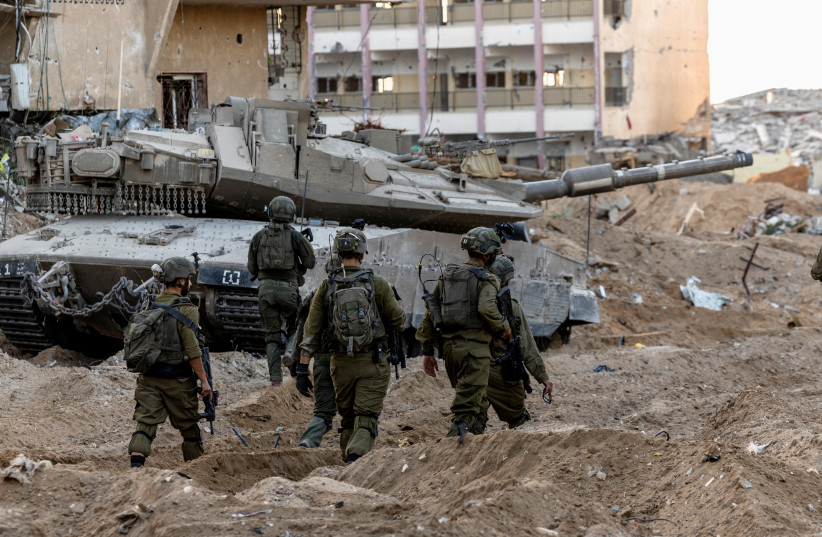There are at least three mysteries in Israel’s intelligence and its handling of Hamas’s abuse of Shifa Hospital in Gaza that remain unresolved after an Israeli withdrawal from the medical center on the eve of the temporary ceasefire.
The first is about the Hamas leaders (see below regarding how high their ranks were) and around 200 terrorists who Israel either allowed to flee or failed to prevent from fleeing.
Although at first the IDF and the government could claim that they did not know that the officials and forces would leave, The Jerusalem Post has now received several confirmations that there was little expectation that most of them would be there by the time Shaldag Special Forces penetrated the complex.
There were concerns that a small number of Hamas terrorists left behind might resist, leading to bloodshed within the hospital’s facilities, which might also harm Palestinian civilians.
Uncovering the mystery
Based on these concerns, the Shaldag (kingfisher) forces blew a hole through a side wall and entered the facility in a manner that would give them the advantage of surprise if some Hamas terrorists remained behind.

However, defense sources said that Hamas fighters likely left by fading into a crowd of around 40,000 Palestinian civilians who were evacuated from Shifa in the days before Shaldag entered.
More recently, the Post has learned that top Hamas officials may have left Shifa long before the multi-day siege, shortly after the IDF began its ground invasion.
The Post has also received significant evidence that hostages and bodies were held at the hospital, specifically in the outpatient building, and were smuggled out.
The method and the extent to which Hamas concealed weapons at Shifa Hospital testified to its having abandoned certain areas more than a few days before Shaldag arrived.
There are signs that the IDF and the government may have even preferred that top Hamas officials and most of the terrorists there would leave before the IDF arrived. This might even include knowingly allowing hostages or bodies to be removed, which could have either been an official or unofficial high-level decision.
The purpose of such a decision would have been to avoid a bloodbath in the hospital that could have harmed the legitimacy of Israel’s war against Hamas, a genuine concern for Palestinian civilians there, and for IDF soldiers and any hostages who might die in a gunfight while soldiers “pulled their punches” around the civilians. Deciding whether this decision was the right one will need to wait until the government and IDF clarify what they knew and when.
This begs the question whether the government and IDF systematically avoided attacks in areas where they suspected Hamas was holding hostages or bodies.
During the first week of the war, a senior diplomatic source and top IDF officials all said that military forces would not “pull their punches” with Hamas, and would not allow the hostage situation to prevent them from dismantling the terrorist group (back then the term was “annihilation”).
On Sunday, hostages were returned to Israel from Shajaiya in northern Gaza. Until now, the IDF has said that it did not attack the Gaza City neighborhood in the belief that surrounding some of the terror group’s toughest forces in Shajaiya would be easier after the rest of northern Gaza was taken.
Possible conclusions
But what if another motivation was that the government and the IDF knew hostages were there and did not want to come anywhere near them for fear of what Hamas would do to them?
This, along with the Shifa story, would help make sense of the fact that the IDF has taken over 80% or more of northern Gaza, including all central Hamas headquarters, while arresting or killing only a third of Hamas’s forces of 30,000, and maybe even fewer.
Maybe the hostage mission actually has been delaying the dismemberment of Hamas all along.
Finally, defense sources dispute which Hamas officials were at Shifa.
Captured Hamas terrorists have told the Shin Bet (Israel Security Agency) and some IDF officials that the Hamas leadership, or at least its highest military leaders, had been there.
Some officials compared the Shifa tunnels to those of Hamas battalion (mid-level) commanders, saying that the Shifa tunnels were in a class of their own.
This would be consistent with most defense officials’ statements about who was hiding at Shifa from 2014 until the eve of the current invasion of Gaza.
On the flip side, other IDF officials, including public spokespeople, have said that Shifa housed battalion commanders, not higher-level leaders.
This could be true, or it could be that if a decision was made to let such leaders escape with hostages, it was desirable not to emphasize that these leaders had been there.
The apparent refusal of the government and the IDF to let Hamas withdraw from Shifa in public - but only quietly as the army managed to demolish only some of the tunnels before the partial hostage release began - will likely leave many of these mysteries open for some time.
